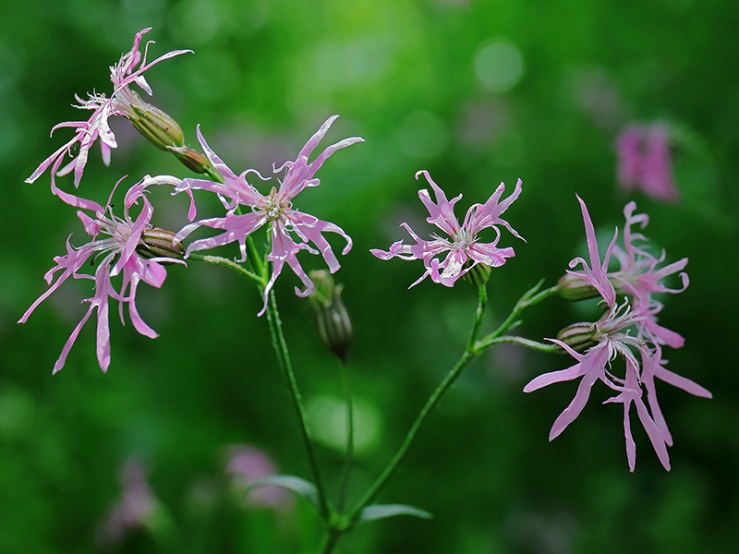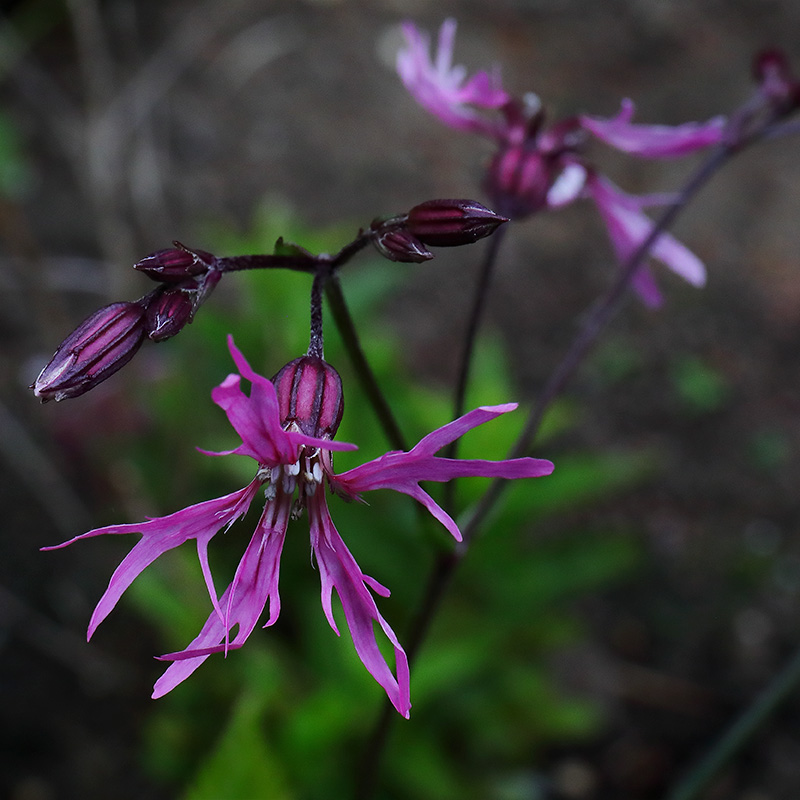NB: A note for WordPress Reader users – you need to click on the title of the post again to see the full photograph. (Otherwise you see just a tiny section!)
Ragged robin (Silene flos-cuculi, also known as Lychnis flos-cuculi) is a very pretty wildflower that is native to Europe and Asia. It grows in damp or marshy ground and was, in the past, a common sight around the UK. (I remember it growing in soggy ditches alongside country roads when I was much younger.) It has become significantly less common now, even rare, due to land development, especially the drainage of ground for agriculture and the loss of wetlands and wild ponds.
Fortunately, ragged robin is now grown as a garden plant. It’s a perennial which seeds itself around very readily in moist and sunny sites. Gardeners can choose cultivars in deep pink, pale pink or white. The pale flowers in the photograph below were growing in the wet ground alongside a large pond in a garden we visited. They were such a lovely sight that I wished I could grow them in my own much drier garden.
The desire to grow plants that like damp conditions led me to create a little ‘bog garden’ last year. That meant that I was able to plant the dark-flowered ragged robin that you can see in the top photo. (I was afraid that the huge increase in our winter rainfall might have drowned the plants in my bog garden, but everything in it is growing again and the ragged robin seems perfectly happy.)
The availability and growing popularity of wildflowers as garden plants helps not only their survival, but that of many insects too. Ragged robin is an excellent source of nectar for bees and butterflies and apparently attracts dragonflies too. I shall be on the lookout for those!


So delicate. Lovely
LikeLiked by 1 person
Thank you Madeline! My husband loves these flowers so I was happy to be able to grow them at last. 🙂
LikeLike
That’s a pretty close-up you opened with. Do you happen to know what the species name flos-cuculi, which means ‘cuckoo flower’, refers to?
LikeLiked by 1 person
Thanks Steve! I’ve read that the name ‘cuckoo flower’ probably relates to it flowering at the same time as we start to hear cuckoos here in the UK.
LikeLike
So lovely, you’ve captured the delicate beauty of ragged robin perfectly! It’s also a native here in northern France (fleur-de-coucou) and we encourage it to self-seed all around the garden, it’s such an excellent flower for insects and definitely one of the treats of the season. 😊
LikeLiked by 1 person
I’m delighted with with these lovely little flowers and I’ll be hoping for some self-seeding here too. (Though I might need to create another small bog-garden to give it some more damp space… 🙂 )
LikeLiked by 1 person
The blooms in your bog garden look as though they love the space you’ve created for them, Ann!
LikeLiked by 1 person
Thank you, that makes me smile! I love the idea of making the garden into a happy habitat for both plants and creatures (and humans too). 🙂
LikeLiked by 1 person
I’m so glad that this pretty flower decided it liked your bog, and to hear that the latter is doing well. May the dragonflies show up next!
LikeLiked by 1 person
I’m pleased that the bog plants have survived a very wet winter – thought it might get too boggy! Dragonflies do find my pond, so I’m hoping that the ragged robin will be an extra attractant for them. (Though it’s usually a bit later on that I see them.)
LikeLiked by 1 person
I’ve come across two native Silene species in my travels here; one is blooming right now. At first, I didn’t think our two looked anything like this one (which shows up primarily as an introduced species in the northeastern states), but the more I looked, the more I realized the similarities don’t so much involve the flowers as other parts of the plant, like the receptacles. Take a look at the pink flower in the upper left of your second photo, and then take a look at this east Texas Silene subciliata. See?
LikeLiked by 1 person
Oh yes, I agree – looking at other pictures too, I can see that the stems and leaves are very similar too. There’s definitely a family resemblance! (Saw your post on subciliata in my search – great pictures! 🙂 )
LikeLiked by 1 person
Such pretty ragged robin photos Ann. I should look for some for my garden, surely they’d like the dampness here? Saying that I don’t think I have seen any locally in the wild.
LikeLiked by 1 person
I think they’d do well in the damp…just the right conditions! And they self-seed very readily. My plant has a seedling from last year already and I’m hoping for more… 🙂
LikeLiked by 1 person
I’ve finally managed to get red campion to flower in my Cornish hedge which makes it more authentic. Just need the cow parsley to find its way!
LikeLiked by 1 person
That would be pretty and good for pollinators too! 🙂
LikeLiked by 1 person
I think I need to look for some to plant here as I think it might do well in the damp Colne Valley microclimate. Haven’t seen any around wild in a while.
LikeLiked by 1 person
They do like damp conditions, so should do well. I think they’re much less common in the wild these days, so gardeners are helping to keep them going. hope you find some!
LikeLiked by 1 person